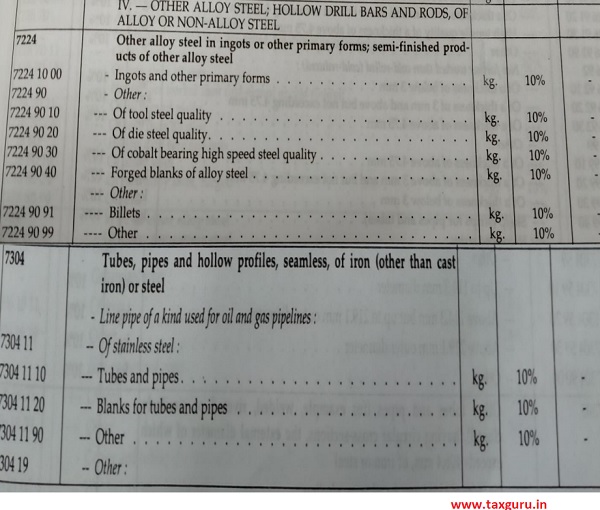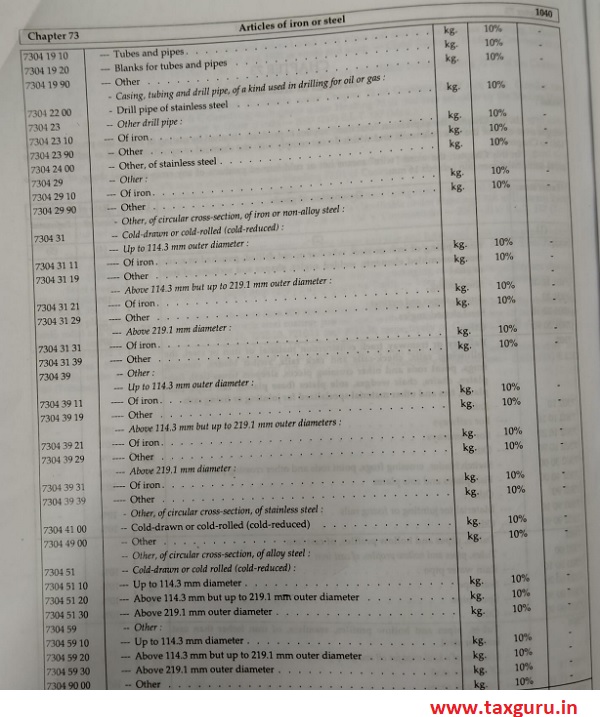Case Law Details
Technocraft Enterprise Vs C.C. (CESTAT Ahmedabad)
We find that the essential dispute is if the product imported by the appellant falls under Chapter Heading 72249099 or Chapter Heading 73049000.
The appellant is seeking classification of the product as semi-finished product of other alloy steel.
it is seen that only product with solid section are classifiable as semi-finished products. The products which are not of solid section cannot be classified as semi-finished products. In view of above, the classification under Chapter Heading 7224 as semi-finished produce has to be ruled out as the product imported by the appellant is not having solid section. The alternate classification suggested by Revenue is 73049090.
It is seen that the said heading covers tubes, pipes and hollow The Revenue is seeking to classify the product as hollow profile. The appellant have argued that the product tubes and pipes and hollow profiles are products made out of the process of extrusion, whereas the product imported by the appellant is a forged product, which has been proof machine. The argument of the appellant is based on the process of manufacture which has no relevance as far as classification under Chapter Heading 7304 is concerned. It is seen that for the purpose of classification in these heading the process of manufacture is not relevant. The appellant has sought classification of the product as ‘other bars and rods’ relying of Chapter Note (m).
It is seen that the product covered are those having uniform solid cross section along their whole length. In the instant case the product does not have solid cross section and therefore, Chapter Note 1(m) has no application.
It clearly covers the hollow products and gives dimensional parameters necessary for the product to fall under Chapter Heading 7304. The product imported by the appellant, therefore, automatically gets classified under Chapter Heading 7304.
The appellant have relied on certain decision of Tribunal (listed in para 1.4 above) which relate to forged products subject to process up to proof machining. However, none of the decisions relate to forged products which are not of solid cross section, and therefore, the said decisions are not relevant for this case.
FULL TEXT OF THE CESTAT AHMEDABAD ORDER
This appeal has been filed by the TECHNOCRAFT ENTERPRISE against changes of classification of the product imported by them.
1.1 The appellant imported goods declared as 700 x 357x 700 SAE 52100 hot forged, spheroidized annealed, proof machined, hollow UT 100% ok as per standard sep 1921 c/c steel round bars (10 pcs) and 622 x 337x 700 SAE 52100 hot forged, spheroidized annealed, proof machined, hollow UT 100% ok as per standard sep 1921 c/c steel round bars (8 pcs). The appellant claimed classification under Customs Tariff heading 72284000 of Customs Tariff Act, 1975 seeking benefit of Exemption Notification 21/2002-Cus dated 01.03.2002 (Serial No. 207) at 5% basic Customs Duty. Revenue on examination of goods disputed the classification declared by the appellant i.e. Customs Tariff Heading 72284000. On being asked to declare full description of the goods so as to justify classification/notification claimed the appellant vide Letter dated 10.07.2010 also declared full description of the goods and requested to finalize the assessment under Chapter Heading 72249099 as “other Alloys Steel Ingot and Other Primary Form, semi-finished product and other Alloys” instead of Customs Tariff Heading 72284000 which they had earlier claimed. On examination the goods were found to be Tubes Hollow. The adjudicating authority relying on Chapter Note 1(p) held that the goods cannot be classified under chapter 72 and ordered classification of the said goods under Chapter Tariff Heading 73049000 of Customs Tariff Act,1975 and ordered the appellant to pay duty accordingly.
1.2 The said order of the adjudicating authority was upheld by the Commissioner (Appeals). Aggrieved by the said order of Commissioner (Appeals), the appellant are before
1.3 The Learned Counsel for the appellant argued that the product imported by them is input for further The process of manufacture was described as follows:
First further rough machining nearer to final accurate dimensions and then heat treatment then initial finishing to final dimensions. The finished blank piece is then heated in a furnace to acquire the required diametric expansion then a shaft (round bar) of alloy steel is inserted across the length of the piece through the open bore. Upon cooling the outer heated forged pieced (having bore) tightly shrink fits to the inside shaft (round bar). The prepared roll is thereafter further finished by finishing machining and final grinding to extreme accurate dimensions. The finished roll is then inspected, tested and if found proper is ready for sale to the user industry i.e. steel sheets cold rolling units.
1.4 It was argued that the goods imported are semi-finished in nature, therefore it has to be classified under Chapter Heading She relied on Chapter note (m) of Chapter 72 to assert that the product clearly confirms to the description other bars and rods. She argued that in the impugned order reliance on the Chapter note (P) of Chapter 72 is incorrect. Learned Counsel relied on the General Rules for the Interpretation of the First Schedule of the Customs Tariff Act to assert that the goods should be classified under Chapter Heading 7224. She particularly relied on Rule 3(a) and 4 of the said Rules. She argued that merely because the forged alloy steel solid bars/rods have a hole does not make the product a hollow profiles. She argued that the Tubes/ Pipes or hollow profile are of extruded products formed using a die of the desired shape. She argued that the present product is not undergone any process of extrusion. She argued that forged alloy steel solid bars/rods might not have a concentric hollow which is an essential character of Tubes/Pipes or hollow profile. She argued that tubular product where inner or outer surface are not of the same form need to be classified as Tubes/Pipes and those not having inner and outer surface of the same form are to be classified as hollow profiles. She argued that the product imported by them cannot be termed as a hollow profile as the inner and outer surface are of the same form. She argued that product imported by them was to be further processed to convert the same into rolls for rolling mills, whereas Tubes, Pipes or hollow profiles are however, put to different use. She relied on the following cases.
- Aravali Forging Vs Collector of Central Excise, Jaipur [1999 (111) ELT 530 (T)]
- Anil Forging Collector of Central Excise, Ahmedabad [1998 (103) ELT 252(T)]
- Steel & Indsutrial Forgings V. Collector of Central Excise [1991 (53) ELT 609 (T)]
2. AR relied on the impugned order.
3. We have gone through rival submissions. We find that the essential dispute is if the product imported by the appellant falls under Chapter Heading 72249099 or Chapter Heading 73049000.
4. The appellant is seeking classification of the product as semifinished product of other alloy steel. It is seen that the Chapter Note (ij) of Chapter 72 describe semifinished product as follows:
“(ij) Semi-finished products:
Continuous cast products of solid section, whether or not subjected to primary hot-rolling; and other products of solid sections, which have not been further worked than subjected to primary hot-rolling or roughly shaped by forging, including blanks for angles, shapes or sections.
These products are not presented in coils.”
From the above, it is seen that only product with solid section are classifiable as semi-finished products. The products which are not of solid section cannot be classified as semifinished products. In view of above, the classification under Chapter Heading 7224 as semifinished produce has to be ruled out as the product imported by the appellant is not having solid section. The alternate classification suggested by Revenue is 73049090.


3.1 It is seen that the said heading covers tubes, pipes and hollow The Revenue is seeking to classify the product as hollow profile. The appellant have argued that the product tubes and pipes and hollow profiles are products made out of the process of extrusion, whereas the product imported by the appellant is a forged product, which has been proof machine. The argument of the appellant is based on the process of manufacture which has no relevance as far as classification under Chapter Heading 7304 is concerned. It is seen that for the purpose of classification in these heading the process of manufacture is not relevant. The appellant has sought classification of the product as ‘other bars and rods’ relying of Chapter Note (m). Chapter Note 1(m) of the Chapter 72 reads as follows:
“(m) Other bars and rods:
Products which do not conform to any of the definitions at (ij), (k) or (l) above or to the definition of wire, which have a uniform solid cross-section along their whole length in the shape of circles, segments of circles, ovals, rectangles (including squares), triangles or other convex polygons (including “flattened circles” and “modified rectangles”, of which two opposite sides are convex arcs, the other two sides being straight, of equal length and parallel). The products may:
– Have indentations, ribs, grooves or other deformations produced during the rolling process (reinforcing bars and rods);
– Be twisted after ”
3.2 It is seen that the product covered are those having uniform solid cross section along their whole length. In the instant case the product does not have solid cross section and therefore, Chapter Note 1(m) has no application. Chapter Note (p) of Chapter 72 reads as follows:
“(p) Hollow drill bars and rods:
Hollos bars and rods of any cross-section, suitable for drills, of which the greatest external dimension of the cross-section exceeds 15mm but does not exceed 52mm, and of which the greatest internal dimension does not exceed one half of the greatest external dimension. Hollow bars and rods of iron or steel not conforming to this definition are to be classified in heading 7304.”
3. It clearly covers the hollow products and gives dimensional parameters necessary for the product to fall under Chapter Heading 7304. The product imported by the appellant, therefore, automatically gets classified under Chapter Heading 7304.
4. The appellant have relied on certain decision of Tribunal (listed in para 1.4 above) which relate to forged products subject to process up to proof machining. However, none of the decisions relate to forged products which are not of solid cross section, and therefore, the said decisions are not relevant for this case.
5. In view of above, we do not find any merit in the appeal filed by the appellant and the same is
(Pronounced in the open court on 01.04.2021 )




